Like I wrote a few posts ago, this blog is mostly for my own use as a journal. I like to keep track of what I was doing and when. I also use it as a scratch pad to think through ideas in writing. This post is an example.
I am en route to Costa Rica for an international faculty development seminar, "Lessons in Sustainability." We will use Monteverde as a case study of how development for ecotourism has posed challenges for the community.
Preparing for this has me thinking about Caye Caulker. I have taken >100 NSU students here since 1999 for classes on "Tropical Ecology" and "Coral Reef Ecology", and have taught my online class, "Environmental Problems" while based here. So I have this little island much in mind as I study for the seminar.
The seminar could very well be conducted here. While the specific issues are site-specific, the general topic is pertinent. Let me start with a brief natural history of this island.
Caye Caulker is small, about 0.5 km wide (east-west) and a few km long (north south). My guess is that the highest points are 2 metres ASL, with most laying lower. It is just (~1 km) inside the Belize barrier reef, the longest such reef in the hemisphere and 2nd only to Australia's globally. That reef protects the island from much of the wave damage from tropical storms.
I was here twice before Hurricane Keith struck in October, 2000. It was a powerful hurricane and did considerable damage.
Many trees were killed, and the few large survivors were severely damaged. The concrete and steel breakwater at the "split" between the settled south of the island and the nearly uninhabitated north was smashed.
Here is a photo of that structure I took two days ago:
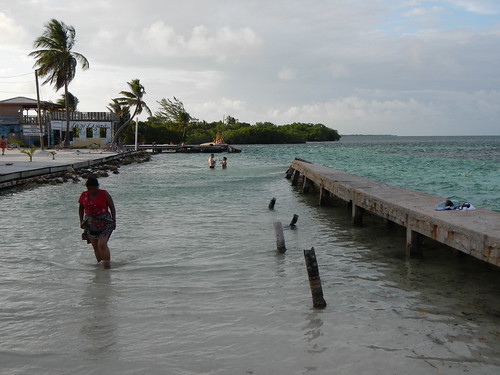
The remnants are visible on the right.
Many wood homes were damaged. Rebuilding tended to be with rebar-reinforced concrete and two or more floors. Power lines were knocked over.
I often wish I had taken photos before Keith for comparison with after. Alas, I did not. So I took several photos of the village on Friday (May 18) and I'll post some here. I'll start with infrastructure basics: power, water. Then food and livelihood, concluding with tourism. I'll finish with telecommunication infrastructure.
BEL sign:
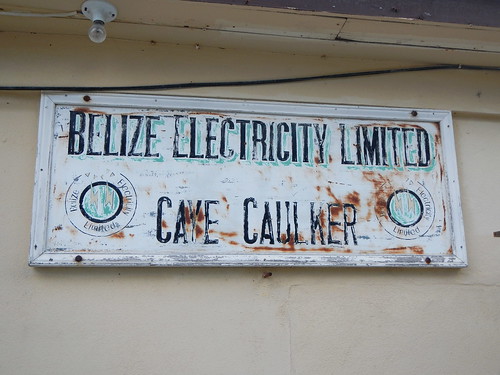
The generator in this building, put up after Keith, has proven inadequate for increasing demand. Ever larger and more numerous diesel generators have been barged to the island:

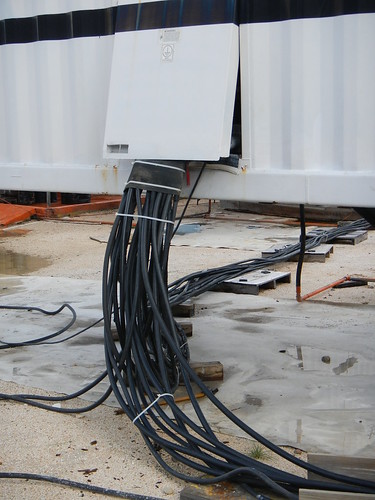
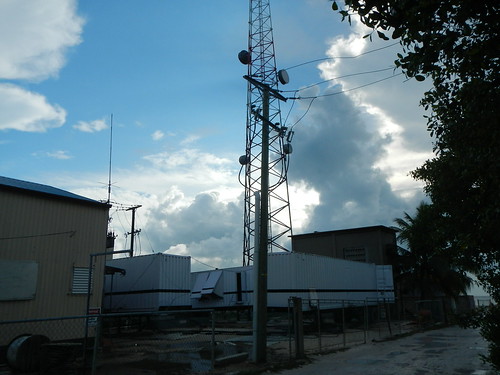
Barge dock by the BEL plant (and BWS, BTL, fuel station, beverage warehouse); note the man in the foreground dredging by hand to make the morage deep enough:
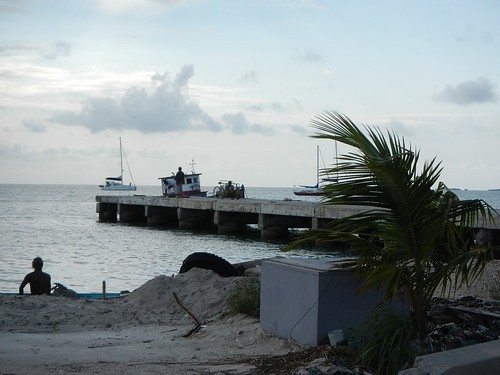
Fuel station for motor vehicles:
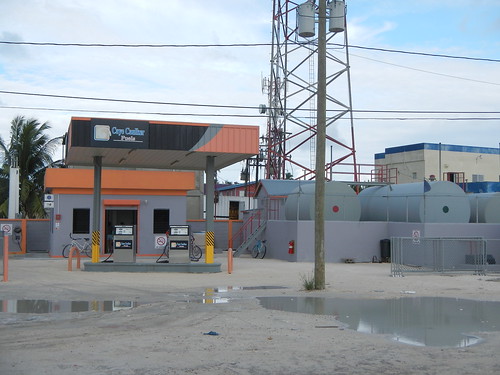
This gas station is new. Until recently, people used bicycles and electric "Golf carts" for transportation (not that everything is not within walking distance). Gas and diesel were sold off the dock for boats, and the few people with trucks refueled out of jugs carried from the fisherman's dock. No more! They can pull their truck up and top the tank. Both fuels are about $11 Belize (~US $ 5.50) per gallon.
The beverage warehouse is located in this area, too:
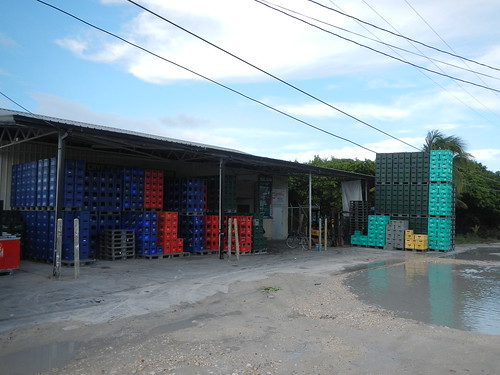
A tourist town consumes many crates of beer and soda. A tractor pulls a trailer to haul crates around the village:

Glass bottles have a cash deposit, plastic ones do not. Many end up in the mangrove swamp, here just feet from the beverage warehouse:
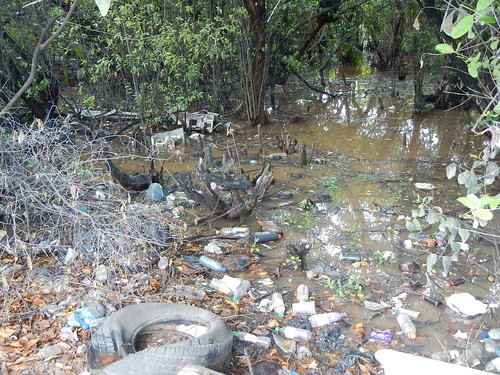
The bottling company has paid for trash receptacles on the beach and in areas frequented by tourists:

but the rest of the village makes due with signs like this:

and warnings like this:
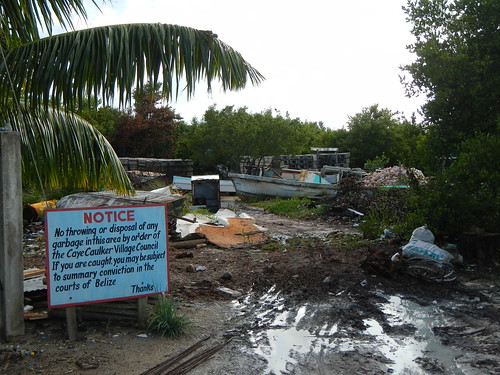
There is a town dump. It is in the mangrove swamp by the airstrip. The trash is piled up and burned. The well-heeled tourists who arrive for their vacations by plane are greeted with the sight and smell of burning plastic trash. It is the first thing they see on the island. Village leaders have discussed moving the dump for many years. It is not practical.
Also on the back side of the island, away from where tourists usually walk, is the newest part of the island infrastructure: the Belize Water Service reverse osmosis treatment plant. Ground water is purified and piped to customers from this imposing hurricane-resistant building:
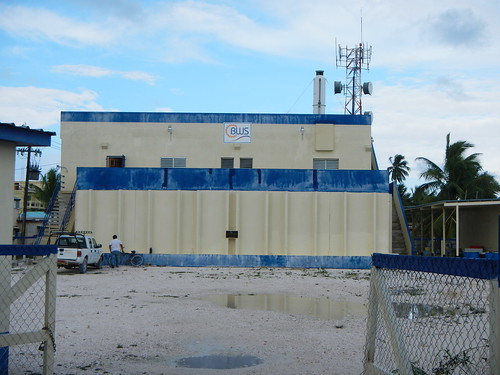
The cost to customers is high, and local people balk at paying. For decades, since the advent of corrugated metal roofing, villages have collected rain water in large wooden cisterns. Many are still in use:
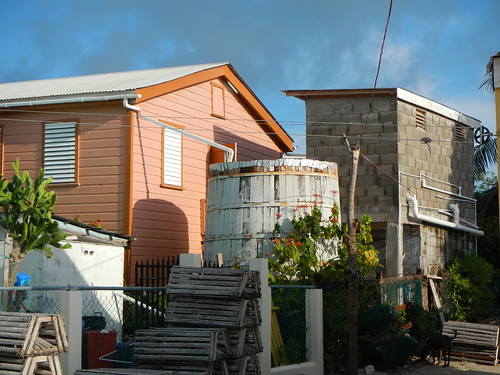
Some families double up to hold water through the long dry season:

The other water source many families use are wells. Well water has a peculiar odor. Local people say it is due to rotting mangrove vegetation and harmless. I (on no evidence) note that wells are often located near septic tanks, which is the method used for sewage disposal. Personally, I drink bottled water. Which comes in plastic bottles from that beverage warehouse (photos above). Is this sustainable?
On to food. The land is not suitable for growing crops, although raised beds for herbs and some vegetables are found. Villagers have long grown two species of food palm. Coconuts (
Cocos nucifera) are ubiquitous. Date palms (
Phoenix dactylifera) used to be commonly grown, but now there are only a few left on the island. Here is a home with both species, behind a fence made of palm leaf sheaths:

Fishing has been the main source of animal protein for, well, probably thousands of years. I am not aware of archeology work on Caye Caulker, but the next island to the north, Ambergris Caye, has Maya ruins from the Classic era. Records of the village date to the mid-19th century when Mestizo refuges from the Caste Wars of the Yucatan arrived. (If you missed that war in your history course, here is a link to a brief overview:
http://ambergriscaye.com/pages/mayan/castewar.html.) Fishing has been the principle economic activity since then. The fishermen of Caye Caulker formed a cooperative in 1960 (http://www.bfca.bz/coop_history.php), which has been successful in sustaining the lobster industry for half a century.
Fishermen build traps with wood of the chit palm (
Thrinax radiata) that look like this:
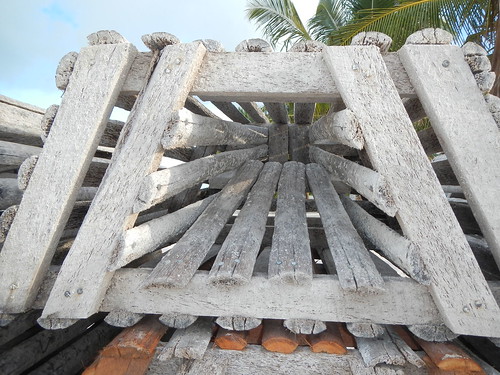
The season is regulated. Right now the season is closed so traps are stored and under repair as needed:

Here is that fisherman's house:

Note the raised height for hurricane surges and to provide a dry place to clothes to hang after wash.
Here are fishing boats:
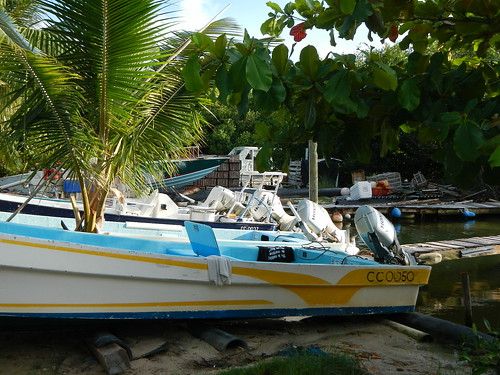
There are several food stores in the village. The older stores, the ones I remember from before Hurricane Keith, look like this:
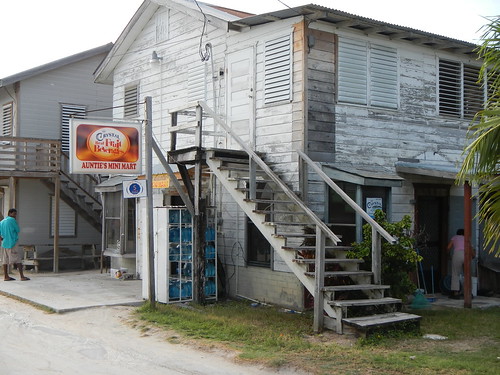
In the past decade, several larger supermarkets owned and operated by Belizeans of Chinese descent have opened, such as this one:
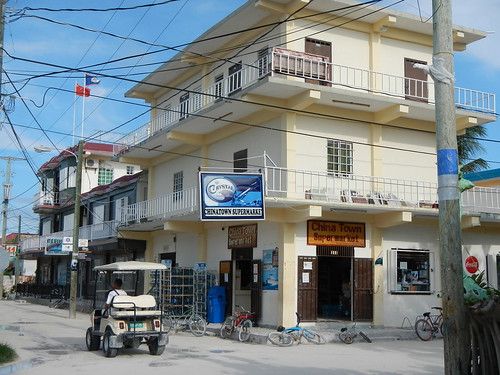
Note the many electric wires over the street. These supply the current for the freezers and refrigerators:

which carry a wide variety of imported foods, such as this selection of cheeses:

Air conditioners are becoming common. This strikes me as pointless, as the constant breezes off the Caribbean moderate the temperature so that the air rarely hits 90 F / 32 C. Tourists apparently expect these electricity hogs, and more and more villages install them as well:
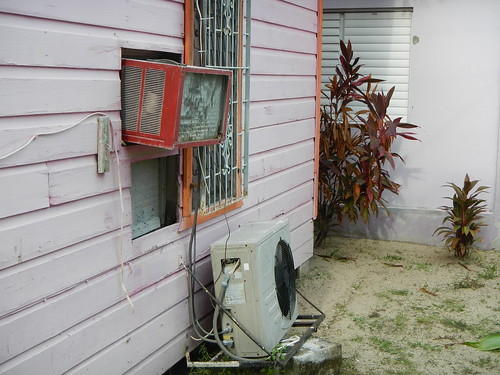
Tourists began coming to Caye Caulker in the 1970s. Snorkeling and SCUBA diving form the basis of the tourist experience:
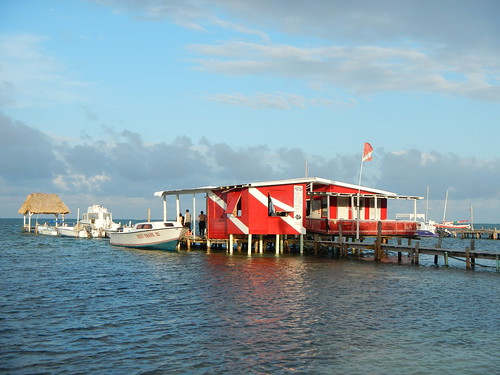
Here on the dock, divers prepare for the dive to come with coffee in styrofoam cups:
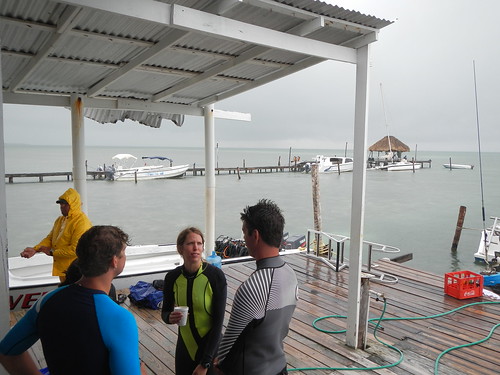
But the divers don't dwell on such contradictions, at least I don't:

This was the first tourist hotel built after Hurricane Keith:
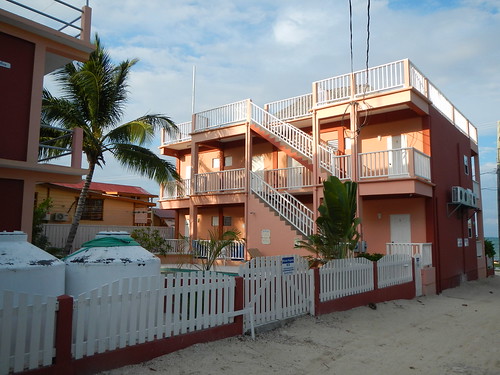
Notice that is is tall and made of concrete. It has AC for each unit and a swimming pool. This seems to be the future of tourist accomodations on Caye Caulker. While no where near the size of the resorts up the coast from Ambergris Caye to Cancun, they are much larger than the cabanas the predominated in the 1990s:
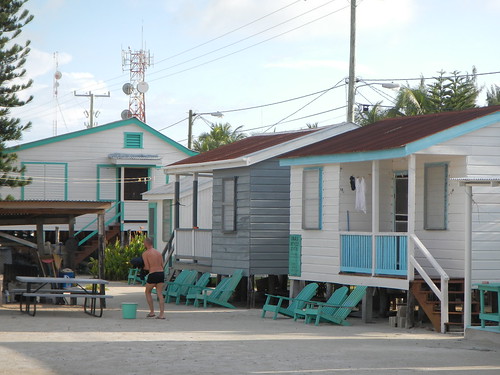
Tourists have some nostalgia for the past, which is accommodated with palapas made with leaves of the bayleaf palm (
Sabal mauritiiformis):
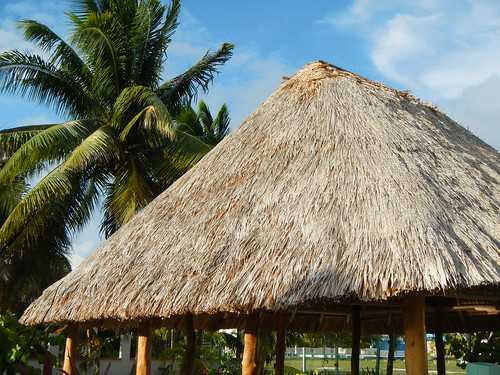
These palm huts look authentic, but bayleaf grows in the rainforests of the mainland, not the Cayes or coast. Also, harvest of bayleaf palm leaves for tourist palapas is not sustainable: leaves are being harvested faster than they grow in the forest.
To
urist demands change over time. Here is a sign outside Marin's restaurant, the first catering to tourists:

Caye Caulker has 3G mobile phone coverage and internet access through Belize Telecommunications, Limited (BTL), housed in a hurricane-resistant building near the back of the island:
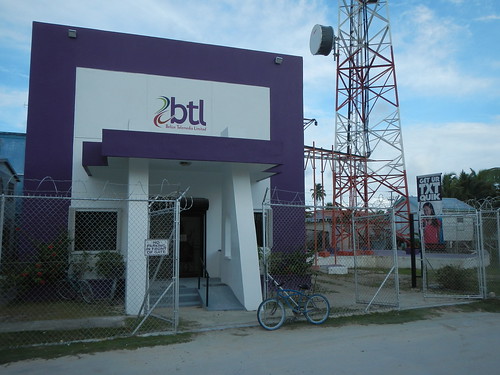
Infrastructure is expanding to serve residents and tourists alike:
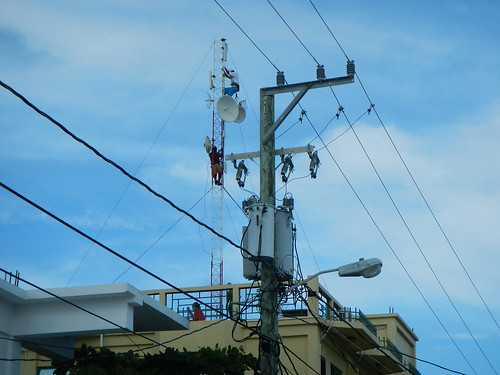
This creates new job opportunities, such as for Golf Cart repair:
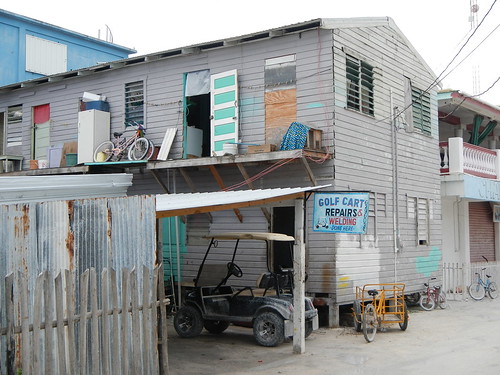
and laundry services:
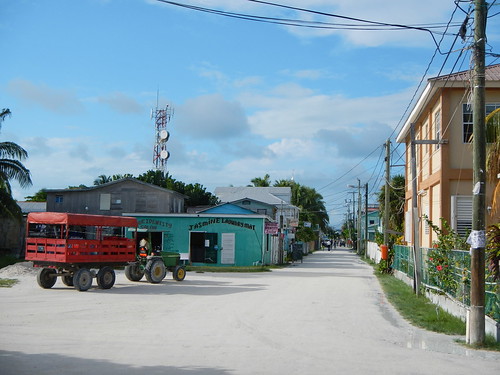
The village council is working on the challenges of development, such as by having a traffic control committee:
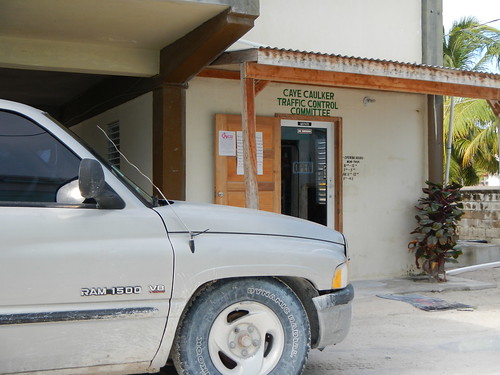
Seeing this Dodge Ram truck with V8 motor makes me smile, as it seems so large for a village so tiny.
What does the future hold for development on Caye Caulker in the second decade after Hurricane Keith? Only Jehovah knows:
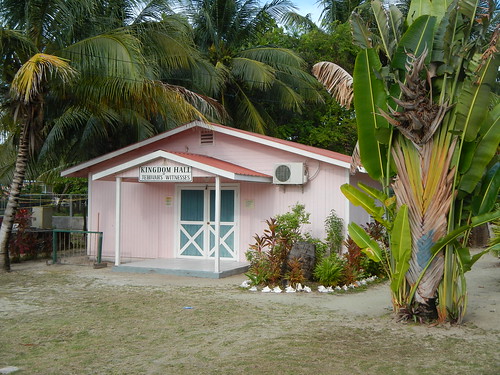
 The remnants are visible on the right.
Many wood homes were damaged. Rebuilding tended to be with rebar-reinforced concrete and two or more floors. Power lines were knocked over.
I often wish I had taken photos before Keith for comparison with after. Alas, I did not. So I took several photos of the village on Friday (May 18) and I'll post some here. I'll start with infrastructure basics: power, water. Then food and livelihood, concluding with tourism. I'll finish with telecommunication infrastructure.
BEL sign:
The remnants are visible on the right.
Many wood homes were damaged. Rebuilding tended to be with rebar-reinforced concrete and two or more floors. Power lines were knocked over.
I often wish I had taken photos before Keith for comparison with after. Alas, I did not. So I took several photos of the village on Friday (May 18) and I'll post some here. I'll start with infrastructure basics: power, water. Then food and livelihood, concluding with tourism. I'll finish with telecommunication infrastructure.
BEL sign:
 The generator in this building, put up after Keith, has proven inadequate for increasing demand. Ever larger and more numerous diesel generators have been barged to the island:
The generator in this building, put up after Keith, has proven inadequate for increasing demand. Ever larger and more numerous diesel generators have been barged to the island:


 Barge dock by the BEL plant (and BWS, BTL, fuel station, beverage warehouse); note the man in the foreground dredging by hand to make the morage deep enough:
Barge dock by the BEL plant (and BWS, BTL, fuel station, beverage warehouse); note the man in the foreground dredging by hand to make the morage deep enough:
 Fuel station for motor vehicles:
Fuel station for motor vehicles:
 This gas station is new. Until recently, people used bicycles and electric "Golf carts" for transportation (not that everything is not within walking distance). Gas and diesel were sold off the dock for boats, and the few people with trucks refueled out of jugs carried from the fisherman's dock. No more! They can pull their truck up and top the tank. Both fuels are about $11 Belize (~US $ 5.50) per gallon.
The beverage warehouse is located in this area, too:
This gas station is new. Until recently, people used bicycles and electric "Golf carts" for transportation (not that everything is not within walking distance). Gas and diesel were sold off the dock for boats, and the few people with trucks refueled out of jugs carried from the fisherman's dock. No more! They can pull their truck up and top the tank. Both fuels are about $11 Belize (~US $ 5.50) per gallon.
The beverage warehouse is located in this area, too:
 A tourist town consumes many crates of beer and soda. A tractor pulls a trailer to haul crates around the village:
A tourist town consumes many crates of beer and soda. A tractor pulls a trailer to haul crates around the village:
 Glass bottles have a cash deposit, plastic ones do not. Many end up in the mangrove swamp, here just feet from the beverage warehouse:
Glass bottles have a cash deposit, plastic ones do not. Many end up in the mangrove swamp, here just feet from the beverage warehouse:
 The bottling company has paid for trash receptacles on the beach and in areas frequented by tourists:
The bottling company has paid for trash receptacles on the beach and in areas frequented by tourists:
 but the rest of the village makes due with signs like this:
but the rest of the village makes due with signs like this:
 and warnings like this:
and warnings like this:
 There is a town dump. It is in the mangrove swamp by the airstrip. The trash is piled up and burned. The well-heeled tourists who arrive for their vacations by plane are greeted with the sight and smell of burning plastic trash. It is the first thing they see on the island. Village leaders have discussed moving the dump for many years. It is not practical.
Also on the back side of the island, away from where tourists usually walk, is the newest part of the island infrastructure: the Belize Water Service reverse osmosis treatment plant. Ground water is purified and piped to customers from this imposing hurricane-resistant building:
There is a town dump. It is in the mangrove swamp by the airstrip. The trash is piled up and burned. The well-heeled tourists who arrive for their vacations by plane are greeted with the sight and smell of burning plastic trash. It is the first thing they see on the island. Village leaders have discussed moving the dump for many years. It is not practical.
Also on the back side of the island, away from where tourists usually walk, is the newest part of the island infrastructure: the Belize Water Service reverse osmosis treatment plant. Ground water is purified and piped to customers from this imposing hurricane-resistant building:
 The cost to customers is high, and local people balk at paying. For decades, since the advent of corrugated metal roofing, villages have collected rain water in large wooden cisterns. Many are still in use:
The cost to customers is high, and local people balk at paying. For decades, since the advent of corrugated metal roofing, villages have collected rain water in large wooden cisterns. Many are still in use:
 Some families double up to hold water through the long dry season:
Some families double up to hold water through the long dry season:
 The other water source many families use are wells. Well water has a peculiar odor. Local people say it is due to rotting mangrove vegetation and harmless. I (on no evidence) note that wells are often located near septic tanks, which is the method used for sewage disposal. Personally, I drink bottled water. Which comes in plastic bottles from that beverage warehouse (photos above). Is this sustainable?
On to food. The land is not suitable for growing crops, although raised beds for herbs and some vegetables are found. Villagers have long grown two species of food palm. Coconuts (Cocos nucifera) are ubiquitous. Date palms (Phoenix dactylifera) used to be commonly grown, but now there are only a few left on the island. Here is a home with both species, behind a fence made of palm leaf sheaths:
The other water source many families use are wells. Well water has a peculiar odor. Local people say it is due to rotting mangrove vegetation and harmless. I (on no evidence) note that wells are often located near septic tanks, which is the method used for sewage disposal. Personally, I drink bottled water. Which comes in plastic bottles from that beverage warehouse (photos above). Is this sustainable?
On to food. The land is not suitable for growing crops, although raised beds for herbs and some vegetables are found. Villagers have long grown two species of food palm. Coconuts (Cocos nucifera) are ubiquitous. Date palms (Phoenix dactylifera) used to be commonly grown, but now there are only a few left on the island. Here is a home with both species, behind a fence made of palm leaf sheaths:
 Fishing has been the main source of animal protein for, well, probably thousands of years. I am not aware of archeology work on Caye Caulker, but the next island to the north, Ambergris Caye, has Maya ruins from the Classic era. Records of the village date to the mid-19th century when Mestizo refuges from the Caste Wars of the Yucatan arrived. (If you missed that war in your history course, here is a link to a brief overview: http://ambergriscaye.com/pages/mayan/castewar.html.) Fishing has been the principle economic activity since then. The fishermen of Caye Caulker formed a cooperative in 1960 (http://www.bfca.bz/coop_history.php), which has been successful in sustaining the lobster industry for half a century.
Fishermen build traps with wood of the chit palm (Thrinax radiata) that look like this:
Fishing has been the main source of animal protein for, well, probably thousands of years. I am not aware of archeology work on Caye Caulker, but the next island to the north, Ambergris Caye, has Maya ruins from the Classic era. Records of the village date to the mid-19th century when Mestizo refuges from the Caste Wars of the Yucatan arrived. (If you missed that war in your history course, here is a link to a brief overview: http://ambergriscaye.com/pages/mayan/castewar.html.) Fishing has been the principle economic activity since then. The fishermen of Caye Caulker formed a cooperative in 1960 (http://www.bfca.bz/coop_history.php), which has been successful in sustaining the lobster industry for half a century.
Fishermen build traps with wood of the chit palm (Thrinax radiata) that look like this:
 The season is regulated. Right now the season is closed so traps are stored and under repair as needed:
The season is regulated. Right now the season is closed so traps are stored and under repair as needed:
 Here is that fisherman's house:
Here is that fisherman's house:
 Note the raised height for hurricane surges and to provide a dry place to clothes to hang after wash.
Here are fishing boats:
Note the raised height for hurricane surges and to provide a dry place to clothes to hang after wash.
Here are fishing boats:
 There are several food stores in the village. The older stores, the ones I remember from before Hurricane Keith, look like this:
There are several food stores in the village. The older stores, the ones I remember from before Hurricane Keith, look like this:
 In the past decade, several larger supermarkets owned and operated by Belizeans of Chinese descent have opened, such as this one:
In the past decade, several larger supermarkets owned and operated by Belizeans of Chinese descent have opened, such as this one:
 Note the many electric wires over the street. These supply the current for the freezers and refrigerators:
Note the many electric wires over the street. These supply the current for the freezers and refrigerators:
 which carry a wide variety of imported foods, such as this selection of cheeses:
which carry a wide variety of imported foods, such as this selection of cheeses:
 Air conditioners are becoming common. This strikes me as pointless, as the constant breezes off the Caribbean moderate the temperature so that the air rarely hits 90 F / 32 C. Tourists apparently expect these electricity hogs, and more and more villages install them as well:
Air conditioners are becoming common. This strikes me as pointless, as the constant breezes off the Caribbean moderate the temperature so that the air rarely hits 90 F / 32 C. Tourists apparently expect these electricity hogs, and more and more villages install them as well:
 Tourists began coming to Caye Caulker in the 1970s. Snorkeling and SCUBA diving form the basis of the tourist experience:
Tourists began coming to Caye Caulker in the 1970s. Snorkeling and SCUBA diving form the basis of the tourist experience:
 Here on the dock, divers prepare for the dive to come with coffee in styrofoam cups:
Here on the dock, divers prepare for the dive to come with coffee in styrofoam cups:
 But the divers don't dwell on such contradictions, at least I don't:
But the divers don't dwell on such contradictions, at least I don't:
 This was the first tourist hotel built after Hurricane Keith:
This was the first tourist hotel built after Hurricane Keith:
 Notice that is is tall and made of concrete. It has AC for each unit and a swimming pool. This seems to be the future of tourist accomodations on Caye Caulker. While no where near the size of the resorts up the coast from Ambergris Caye to Cancun, they are much larger than the cabanas the predominated in the 1990s:
Notice that is is tall and made of concrete. It has AC for each unit and a swimming pool. This seems to be the future of tourist accomodations on Caye Caulker. While no where near the size of the resorts up the coast from Ambergris Caye to Cancun, they are much larger than the cabanas the predominated in the 1990s:
 Tourists have some nostalgia for the past, which is accommodated with palapas made with leaves of the bayleaf palm (Sabal mauritiiformis):
Tourists have some nostalgia for the past, which is accommodated with palapas made with leaves of the bayleaf palm (Sabal mauritiiformis):
 These palm huts look authentic, but bayleaf grows in the rainforests of the mainland, not the Cayes or coast. Also, harvest of bayleaf palm leaves for tourist palapas is not sustainable: leaves are being harvested faster than they grow in the forest.
To
urist demands change over time. Here is a sign outside Marin's restaurant, the first catering to tourists:
These palm huts look authentic, but bayleaf grows in the rainforests of the mainland, not the Cayes or coast. Also, harvest of bayleaf palm leaves for tourist palapas is not sustainable: leaves are being harvested faster than they grow in the forest.
To
urist demands change over time. Here is a sign outside Marin's restaurant, the first catering to tourists:
 Caye Caulker has 3G mobile phone coverage and internet access through Belize Telecommunications, Limited (BTL), housed in a hurricane-resistant building near the back of the island:
Caye Caulker has 3G mobile phone coverage and internet access through Belize Telecommunications, Limited (BTL), housed in a hurricane-resistant building near the back of the island:
 Infrastructure is expanding to serve residents and tourists alike:
Infrastructure is expanding to serve residents and tourists alike:
 This creates new job opportunities, such as for Golf Cart repair:
This creates new job opportunities, such as for Golf Cart repair:
 and laundry services:
and laundry services:
 The village council is working on the challenges of development, such as by having a traffic control committee:
The village council is working on the challenges of development, such as by having a traffic control committee:
 Seeing this Dodge Ram truck with V8 motor makes me smile, as it seems so large for a village so tiny.
What does the future hold for development on Caye Caulker in the second decade after Hurricane Keith? Only Jehovah knows:
Seeing this Dodge Ram truck with V8 motor makes me smile, as it seems so large for a village so tiny.
What does the future hold for development on Caye Caulker in the second decade after Hurricane Keith? Only Jehovah knows:

No comments:
Post a Comment